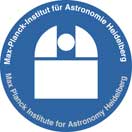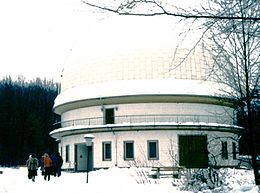A binary system is a system of two astronomical bodies which are close enough that their gravitational attraction causes them to orbit each other around a barycenter (also see animated examples). More restrictive definitions require that this common center of mass is not located within the interior of either object, in order to exclude the typical planet–satellite systems and planetary systems.

Stardome Observatory is a public astronomical observatory situated in Maungakiekie/One Tree Hill Domain in Auckland, New Zealand.
Martin Schwarzschild was a German-American astrophysicist.
Freimut Börngen was a German astronomer and a prolific discoverer of minor planets. A few sources give his first name wrongly as "Freimuth". The Minor Planet Center credits him as F. Borngen.

A Schmidt camera, also referred to as the Schmidt telescope, is a catadioptric astrophotographic telescope designed to provide wide fields of view with limited aberrations. The design was invented by Bernhard Schmidt in 1930.

Onsala Space Observatory (OSO), the Swedish National Facility for Radio Astronomy, provides scientists with equipment to study the Earth and the rest of the Universe. The observatory operates two radio telescopes in Onsala, 45 km south of Gothenburg, and takes part in several international projects. Examples of activities:

The Low-Frequency Array, or LOFAR, is a large radio telescope, with an antenna network located mainly in the Netherlands, and spreading across 7 other European countries as of 2019. Originally designed and built by ASTRON, the Netherlands Institute for Radio Astronomy, it was first opened by Queen Beatrix of The Netherlands in 2010, and has since been operated on behalf of the International LOFAR Telescope (ILT) partnership by ASTRON.

The Vainu Bappu Observatory is an astronomical observatory owned and operated by the Indian Institute of Astrophysics. It is located at Kavalur in the Javadi Hills, near Vaniyambadi in Tirupathur district in the Indian state of Tamil Nadu. It is 200 km south-west of Chennai and 175 km south-east of Bangalore.

The Max-Planck-Institut für Astronomie is a research institute of the Max Planck Society (MPG). It is located in Heidelberg, Baden-Württemberg, Germany near the top of the Königstuhl, adjacent to the historic Landessternwarte Heidelberg-Königstuhl astronomical observatory. The institute primarily conducts basic research in the natural sciences in the field of astronomy.

30 Arietis is a 6th-apparent-magnitude multiple star system in the constellation of Aries. 30 Arietis is the Flamsteed designation. 30 Arietis A and B are separated by 38.1″ or about 1,500 AU at a distance of 130 light years away. The main components of both systems are both binaries with a composite spectra belonging to F-type main-sequence stars, meaning they are fusing hydrogen in their cores. The 30 Arietis system is 910 million years old, one fifth the age of the Sun.

Hamburg Observatory is an astronomical observatory located in the Bergedorf borough of the city of Hamburg in northern Germany. It is owned and operated by the University of Hamburg, Germany since 1968, although it was founded in 1825 by the City of Hamburg and moved to its present location in 1912. It has operated telescopes at Bergedorf, at two previous locations in Hamburg, at other observatories around the world, and it has also supported space missions.

The Llano del Hato National Astronomical Observatory is an astronomical observatory in Venezuela. It is 3600 meters above sea level and is the country's main observatory. It is situated above the village of Llano del Hato in the Venezuelan Andes, not far from Apartaderos which lies about 50 kilometers north-east of Mérida, Mérida State.

The Shamakhy Astrophysical Observatory, named after Nasreddin Tusi of the National Academy of Sciences of Azerbaijan , was established on November 17, 1959, by decree No. 975 of the Council of Ministers of the Azerbaijan SSR. ShAO operates as a research institute within the ANAS Department of Physical, Mathematical, and Technical Sciences. The Observatory is located in the north-east of the Greater Caucasus Range, 150 km from the city of Baku, in the eastern part of Mount Pirkuli, at an altitude of 1435–1500 m above sea level, in geographical coordinates λ = 48⁰ 35' 04" E, φ = 40⁰ 46 '20"N. Here the number of clear nights suitable for observation reaches 150-180 per year.

Leibniz Institute for Astrophysics Potsdam (AIP) is a German research institute. It is the successor of the Berlin Observatory founded in 1700 and of the Astrophysical Observatory Potsdam (AOP) founded in 1874. The latter was the world's first observatory to emphasize explicitly the research area of astrophysics. The AIP was founded in 1992, in a re-structuring following the German reunification.

HD 13189 is an 8th magnitude star in Triangulum constellation.

Urania Sternwarte is a public observatory in the Lindenhof quarter of Zürich, Switzerland. Its name Urania refers to the muse of astronomy in Greek mythology.
11 Ursae Minoris is a single star located approximately 410 light years away in the northern circumpolar constellation of Ursa Minor. The star is visible to the naked eye as a faint, orange-hued star with an apparent visual magnitude of 5.15. It is moving closer to the Earth with a heliocentric radial velocity of −17.5 km/s.
Artie P. Hatzes is an American astronomer. He is a professor at the Friedrich Schiller University of Jena and director of the Karl Schwarzschild Observatory.

Thomas K. Henning is a German astrophysicist. Since 2001, he is a director at the Max Planck Institute for Astronomy. Henning is an expert in the field of star and planet formation.
















